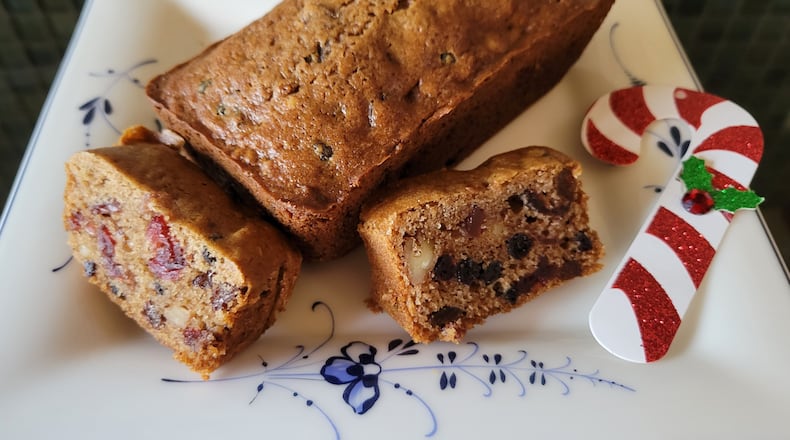The dense combination of fruits, nuts, and just enough cake to hold them together is one of the heaviest baked goods out there. But it also has a lot of interesting history.
To sustain troops in battle, the ancient Romans made a sort of energy bar called satura which consisted of pomegranate seeds, pine nuts, raisins, barley mash and honeyed wine. It is believed that the combination was healthy enough to fortify a soldier through a long strenuous day.
Dried fruits became more readily available to western Europeans during the Middle Ages, and variations of the fruitcake emerged: Italy’s panforte and panettone, Germany’s powdered sugar coated stollen and Britain’s plum pudding. The British form started as “plum porridge”; more liquid than solid, it was not sweet at all. During Shakespearean times it contained meat, wine, sherry fruit juices, sugar, and preserved fruits.
Over the years, the recipe changed to eliminate the meat, add more fruit, and bake it into what became known as “plum pudding.” It was the practice of English nobles in Victorian England to feed the poor carolers with a slice of this pudding which is probably how the Christmas fruitcake came to be so intertwined with Christmas. The fruitcake was brought to America by the colonists in the years before the Revolution, and by the late 1800s the fruitcake was gifted in decorated tins.
Fruitcake Trivia:
- Fruitcake is also known as Christmas cake and black cake.
- Once candied fruit was produced in the 1500′s, fruit cake became more common.
- Fruitcake can be preserved for over 20 years with the use of alcohol, even without refrigeration.
- In 2006, Americans mailed 3,952 lbs. of fruit cake to soldiers stationed in Iraq.
- December 27th is National Fruitcake Day
- A pineapple fruitcake was taken on the Apollo 11 space mission.
- Every year in January, the Colorado town of Manitou Springs hosts the Great Fruitcake Toss. Competitors compete to see how far they can launch a fruitcake, and the event is to raise money for a local charity.
- Fruitcake, in some countries, is covered with icing, or marzipan, or eaten with cream.
- In Claxton Georgia, two bakeries, Claxton Bakery and Georgia Fruitcake Company yield more than 4 million pounds of fruitcake each year.
Fruitcake
Makes 24 Servings
204 Calories Per Serving
Ingredients:
1.5 cups fresh orange juice
1.5 cups chopped candied orange peel
1 cup chopped dried cherries
1 cup chopped dried apricots
1 cup chopped dried pineapple
¾ cup currants
1 cup all-purpose flour, divided
¾ cup whole-wheat pastry flour
1 teaspoon ground cinnamon
½ teaspoon ground allspice
½ teaspoon baking powder
½ teaspoon salt
½ cup sugar
¼ cup mild extra virgin olive oil
2 tablespoons unsalted butter, room temperature
3 tablespoons molasses
1 teaspoon vanilla extract
2 large egg whites, divided
3 tablespoons chopped red cherries for garnish
8 pecan halves for garnish
Directions:
- Preheat oven to 275 degrees F. Coat two (8 ½ x4 ½) loaf pans or 3 mini loaf pans (6x3 inch) with cooking spray and coat with flour.
- Bring orange juice to a simmer in small pot over medium-high heat. Mix orange peel, dried cherries, apricots, pineapple, and currants in a large bowl; pour the warm juice over the fruit and let sit until most of liquid is absorbed, about 10 minutes. Strain out excess juice; toss the fruit with ½ cup all-purpose flour until well coated. Set aside.
- Whisk the remaining ½ cup all purpose flour, whole-wheat flour, cinnamon, allspice, baking powder and salt in a medium bowl until blended.
- Place sugar, oil, and butter in a large bowl. Beat with an electric mixer on medium speed until smooth and creamy, about 2 minutes. Beat in molasses and vanilla, then add egg whites one at a time.
- Stir in dry ingredients. Pour the batter over the fruit and mix well. Divide the mixture among the prepared pans. Decorate the tops with cherries and pecans.
- Bake the cakes until lightly browned and firm to the touch, about 1 hour and 40 minutes. Let cool for 10 minutes.
Interested in free nutrition education lessons from OSU Extension EFNEP? Contact Nancy Lyons at 937-224-9654 or lyons.489@osu.edu.
About the Author
